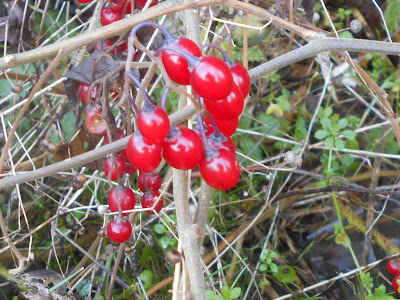Blackbirds , clucking with indignation, scattered as I approached. They are probably finding feeding easy, judging by the number of berries available but unconsumed. One bright and shining example was Bittersweet, Solanum dulcamara. This relative of potatoes and tomatoes has succulent berries but birds have so far resisted the temptation to consume these berries for it seems, as I have mentioned before, that they are relatively unpalatable. They are poisonous too (for humans) but only mildly so.
 |
Attractive but not, it seems, tempting to the local birds. Bittersweet, aka
Woody Nightshade, in Stefen Hill Pocket Park. 22 December, 2019
|
Several species of plant were putting on steady growth but as yet there was no sign of flowers, just greenery. Snowdrops, probably Galanthus nivalis, were pushing through, forming what every year are increasingly extensive patches.
 |
Snowdrops are pushing through. Their flowers will be visited by early bees.
Stefen Hill Pocket Park, Daventry. 22 December, 2019
|
(I read recently of a woman who, only this year, was showing a botanist friend her Turkish holiday snaps who recognised from them - or should I say failed to recognise - a snowdrop species which proved to be new to science. It has been named Galanthus bursanus and is, it seems, already vulnerable due to deforestaation.)
The bright green foliage of Cow Parsley, Anthriscus sylvestris, was everywhere. In Northamptonshire it is always known as Keck, and is as abundant now as it was in my childhood.
 |
Keck, Anthriscus sylvestris, in Stefen Hill Pocket Park.
22 December, 2019
|
It has shining green, virtually hairless foliage. With it grew Upright Hedge-parsley, Torilis japonica. They were easy to distinguish because the latter has slightly downy leaves, giving them a rather greyish appearance. It bore extensive mines formed by the larvae of a fly, Phytomyza chaerophylli. This patterning can be quite attractive and may explain the name of the insect, chaerophylli meaning 'pleasing leaves'. This fly will on occasion attack Cow Parsley but I saw no evidence of his today.
 |
The leaves of Upright Hedge-parsley mined by Phytomyza chaerophylli.
Stefen Hill Pocket Park, Daventry. 22 December, 2019
|
So my walk was not entirely without interest (for me at least) but at this time of the year the sun sets very early and is accompanied by a noticeable drop in temperature. I scurried home to begin packing for our Christmas holiday which will involve a log cabin in the Cotswolds.
No comments:
Post a Comment